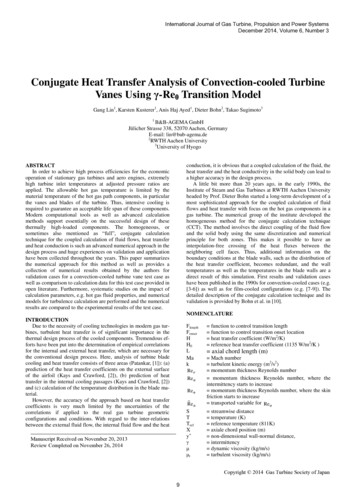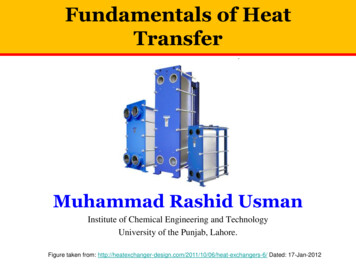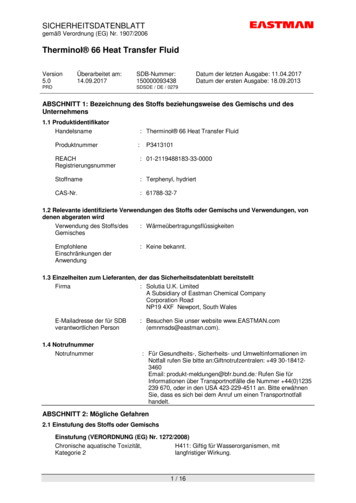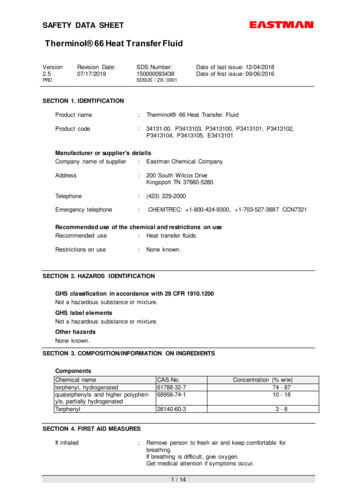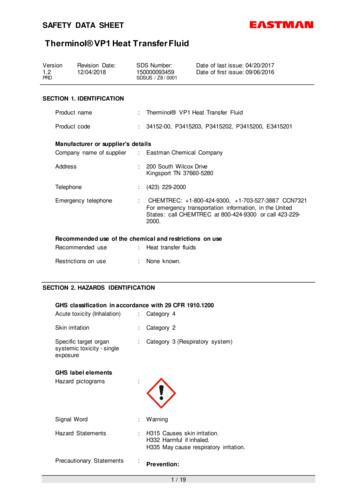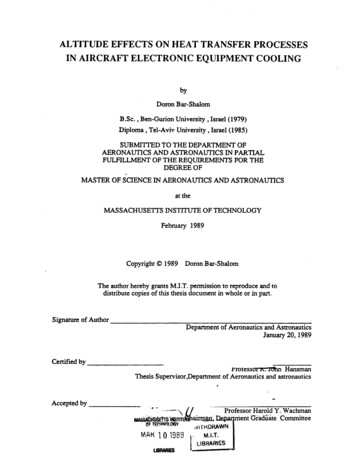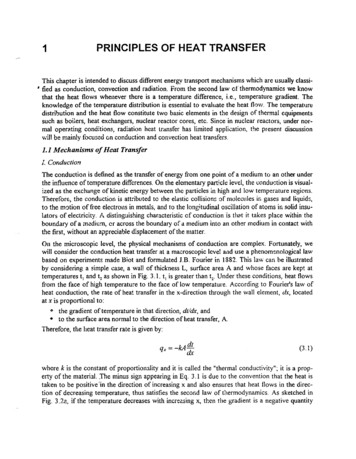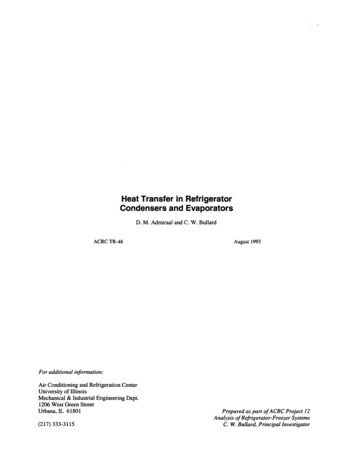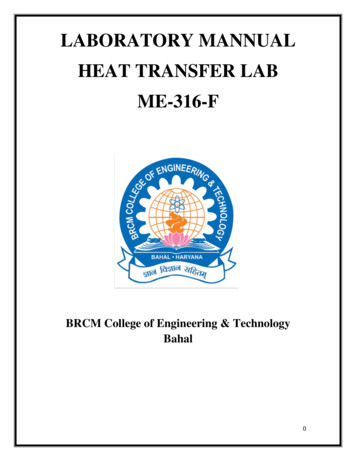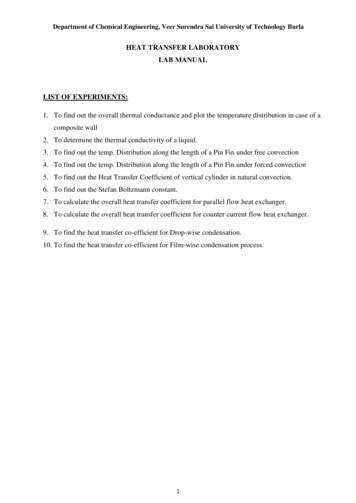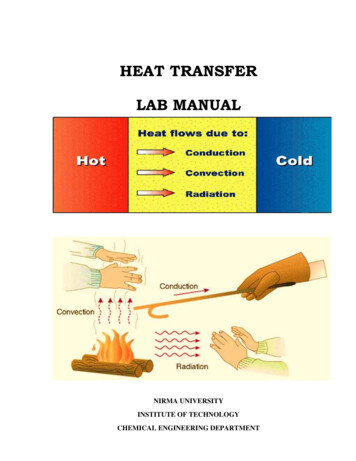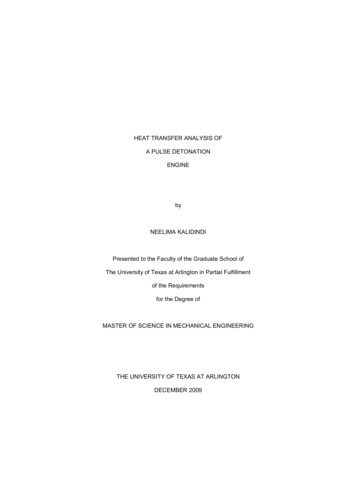
Transcription
HEAT TRANSFER ANALYSIS OFA PULSE DETONATIONENGINEbyNEELIMA KALIDINDIPresented to the Faculty of the Graduate School ofThe University of Texas at Arlington in Partial Fulfillmentof the Requirementsfor the Degree ofMASTER OF SCIENCE IN MECHANICAL ENGINEERINGTHE UNIVERSITY OF TEXAS AT ARLINGTONDECEMBER 2009
Copyright by NEELIMA KALIDINDI 2009All Rights Reserved
ACKNOWLEDGEMENTSIt is a pleasure to thank those who made this thesis possible with their supportand encouragement which helped me to reach this milestone in my life. First, I would liketo take this opportunity to thank my supervising advisor Dr. Frank Lu, Professor andDirector of Aerodynamics Research Center, who has been abundantly helpful andassisted me in numerous ways. With his enthusiasm, his inspiration and his great effortsto explain things clearly and simply, he helped me in making my thesis easier.Throughout my thesis, he provided sound advice, encouragement, good company with lotof good ideas and remarkable patience.Secondly, I am grateful to Dr.A. Haji Sheikh who taught me the required conceptsthrough his course and for his valuable suggestions in the area of heat transfer. He is oneof those professors who always maintained an ever-standing open door policy to guidestudents on their tasks in hand by his kind support. I am also grateful to Dr. DonaldWilson for his constant help and support whenever required. In spite of being busy, he isalways there for the group meetings by providing academic support as well as ambition toexplore new ideas and concepts.Lastly and most important, I cannot end without thanking my father KrishnamRaju, mother Varalakshmi, brother Phani Kishore and fiancé Mohan Raju on whoseconstant love and encouragement I have relied all through my academic life. I am alsothankful to all my friends from University of Texas at Arlington for being the surrogatefamily during the two years and for their continued moral support.November 23, 2009iii
ABSTRACTHEAT TRANSFER ANALYSIS OFA PULSE DETONATIONENGINENEELIMA KALIDINDI, MSThe University of Texas at Arlington, 2009Supervising Professor: Dr. Frank LuA thermal analysis of the effect of sensible heat release on the walls of thedetonation chamber for stoichiometric mixtures of hydrogen/air, octane/air andoctane/oxygen was presented. The detonation tube was assumed to operate at 20 Hzand cooled by a water jacket to dissipate the heat from the walls which ensures theeffective operation for a longer period. Wall material was assumed to be made of copperbecause of its high thermal conductivity.The study showed a slow temperature rise along the walls of the combustionchamber for multiple pulses. It can be concluded that due to the space-time averagingprocedure throughout the length of the tube, the temperature rise along the inner andouter walls are small. Even after 3000 pulses, the temperatures along the surfaces werealmost steady.iv
TABLE OF CONTENTSACKNOWLEDGEMENTS . iiiABSTRACT . ivLIST OF ILLUSTRATIONS . viiiLIST OF TABLES . xNOMENCLATURE . xiChapterPage1. INTRODUCTION . 11.1 Pulse Detonation Engine . 11.2 Operating Principle of Pulse Detonation Engine . 21.2.1 Filling Process . 31.2.2 CJ Detonation Process . 31.2.3 Taylor Rarefaction Process . 41.2.4 Reflected Rarefaction Process . 41.2.5 Exhaust Process . 41.2.6 Purging Process. 41.3 Objective of the Current Research . 51.4 Heating Analysis . 51.4.1 Energy Equation . 52. THERMODYNAMIC CALCULATIONS . 72.1 Prior Research . 72.2 Properties of CJ Detonation Wave . 8v
2.3 Average Conditions during Detonation Process . 112.4 Boundary Conditions of Rarefaction Wave . 142.5 Average Conditions during Unsteady Rarefaction Process . 152.5.1 Comparison of Unsteady RarefactionProperties of Hydrogen/Air, Octane/Airand Octane/Oxygen . 172.6 Calculation of Heat Generation for One Cycle of Operation . 223. DETERMINATION OF DETONATION WALL TEMPERATURES . 253.1 Introduction . 253.2 Fuel Type . 263.3 Transient Heat Analysis using Green’s Function . 273.4 Calculation of Wall Temperatures TW 1 and TW 2 . 283.4.1 Hydrogen and Air . 283.4.2 Octane and Air . 323.4.3 Octane and Oxygen . 353.4.4 Comparison of Heating and Cooling Pulse Profiles forThree Stoichiometric Mixtures . 363.5 Calculation of Wall Temperatures for Large Number of Cycles . 383.5.1 Hydrogen and Air . 383.5.2 Octane and Air . 403.5.3 Octane and Oxygen . 414. CONCLUSION AND DISCUSSION OF RESULTS . 434.1 Conclusion . 434.2 Results and Discussion . 444.3 Recommendations . 44vi
APPENDIXA. CEA CODE – INPUT AND OUTPUT . 45REFERENCES. 47BIOGRAPHICAL INFORMATION . 49vii
LIST OF ILLUSTRATIONSFigurePage1.1 Schematic of PDE showing variousstages during one cycle . 32.1 Flame propagation from left to right. 92.2 Pressure distribution of detonation wave for threestoichiometric mixtures along the length of the tube . 122.3 Properties of detonation wave for three stoichiometric mixturesalong the length of the tube (a) density and (b) temperature. 132.4 Temperature distribution at various times of unsteady rarefactionwave for hydrogen/air till the exit of the tube . 17.2.5 Properties of unsteady rarefaction wave for hydrogen/air till theexit of the tube (a) density at various times (b) pressure at various times . 182.6 Comparison of temperature profiles of unsteady reflected rarefaction wavefor the three stoichiometric mixtures at, t 0.001 sec . 192.7 Comparison of temperature profiles of unsteady reflected rarefactionwave for the three stoichiometric mixtures at various times(a) temperature profile at, t 0.002 sec and(b) temperature profile at the exit of the wave . 202.8 Comparison of density’s at various times forthree stoichiometric mixtures . 212.9 Comparison of pressure’s at various times forthree stoichiometric mixtures . 222.10 Application of energy conservation principle toa steady flow open system . 233.1 Cross sectional view of detonation tube . 263.2 Variations in temperature along the inner wall (TW ) for np 1(a) heating pulse and (b) cooling pulse. 29viii
3.3 Variation in temperatures along the inner wall (TW ) during one cycle. 303.4 Variations in temperature along outer wall (TW ) for np 1(a) heating pulse and (b) cooling pulse. 313.5 Variation in temperatures along the outer wall (TW )during one cycle . 323.6 Comparison of inner surfaces of one heating pulse for octane/air . 333.7 Comparison of outer surfaces of one cooling pulse for octane/air . 343.8 Variation in temperature for one cycle along inner and outersurfaces for octane/air . 343.9 Variation in temperatures for one cycle along inner and outer wallsfor octane/oxygen . 353.10 Inner and outer surface profiles for three stoichiometric mixturesfor one heating pulse . 363.11 Inner and outer surface profiles for three stoichiometric mixturesfor one cooling pulse . 373.12 Inner and outer surface profiles for three stoichiometric mixtures for one pulse . 383.13 Inner surface temperature profiles with number of pulses . 393.14 Outer surface temperature profiles for increasing pulses . 403.15 Inner and outer surface temperature profiles for increasing pulsesfor octane/air . 413.16 Inner and outer wall temperature profiles for increasingpulses for octane/oxygen . 42ix
LIST OF TABLESTablePage2.1 Detonation Wave Propagation Time. 92.2 Detonation Properties of Stoichiometric Hydrogen and Air . 102.3 Detonation Properties of Stoichiometric Octane and Air . 102.4 Detonation Properties of Stoichiometric Octane and Oxygen . 112.5 Rarefaction Properties of Hydrogen/Air . 142.6 Rarefaction Properties of Octane/Air . 142.7 Rarefaction Properties of Octane/Oxygen . 152.8 Exit Conditions for Rarefaction Wave of Hydrogen/Air . 162.9 Exit Conditions for Rarefaction Wave of Octane/Air . 162.10 Exit Conditions for Rarefaction Wave of Octane/Oxygen . 162.11 Inlet and Exit Enthalpy Calculations . 232.12 Total Heat Generated for the Three Stoichiometric Mixtures. 24x
NOMENCLATURE Sonic speed of gasACircumferential area of the detonation tubeC Specific heat at constant pressureC Specific heat at constant volumeCEAChemical Equilibrium with Applications (code)D Speed of Chapman-Jouguet detonation wavefFrequencyF(r )Initial temperature distribution equation at location rg(r , τ) Volumetric energy equation at location r and timeGGreen’s function ℎChange in enthalpyHOverall heat transfer coefficientKThermal conductivityLLength of the pulse detonation engineMMass flow rate of the gasM Chapman-Jouguet detonation Mach numbernpNumber of cyclespPressurePDEPulse detonation engineQHeat fluxxi
Q(Heat release during one cycler)Inner radius of the detonation tuber*Outer radius of the detonation tubeRGas constantTTimetTime of rarefaction wavet -).Time taken during filling processt /0Time taken during purging processt 010Time taken during rarefaction processt 23Time taken during detonation processt 456Time taken during exhaust processt 272Period of cyclic pulse detonation engine operationTTemperatureTWTemperature of the inner wall of the detonation tubeTW Temperature of the outer wall of detonation tubeT8Ambient temperatureTime due to pulse of heatv, uVelocity of the gas flowVVolume of the detonation tubeXReference location inside the detonation tubex Axial distance from the closed endΓGammaΡDensityΑThermal expansion coefficientxii
SubscriptseExit of heat exchangerexOpen-end boundary of rarefaction wave originating from open endiInlet of heat exchanger1Undisturbed state of the detonable mixture2Chapman-Jouguet state3Rear boundary of rarefaction wave Ambient surroundingsxiii
CHAPTER 1INTRODUCTION1.1 Pulse Detonation EngineThe potential advantages of pulse detonation engines (PDEs) over conventionaldeflagration-based engines have been investigated for many years. Copious publicationshave appeared describing the potential for this type of propulsive device. Pulsedetonation engine offer a low - cost alternative to existing engines due to their highthermodynamic cycle efficiency, lack of moving parts, high thrust-to-weight ratio, simplestructure, operational range, low acquisition and maintenance cost. Hence it is expectedto be a high performance, future generation aerospace propulsion engine.System studies of PDEs as is common in the study of energy conversionprocesses use a quasi-one-dimensional approach. For simplicity in this study, the PDE isassumed to be a straight tube with constant cross section in which one end of the tube isclosed and other end is open. A detonation wave is ignited at the closed end. It is usualto assume that the flow is independent of viscous effects and thermal conduction.A detonation wave is simply described as one-dimensional structure consisting ofa leading shock wave followed by a coupled reaction zone which propagates at a steadyvelocity termed as the Chapman-Jouguet (CJ) detonation velocity, which depends on themixture initial parameters like temperature, pressure and energy content. In PDEs, theignition of the fuel has been given much attention since it involves difficulties in rapidlymixing the fuel and oxidizer at high speeds and initiating, maintaining the detonation in acontrolled manner.1
Though most researchers have been concentrating on the detonation process,not much attention has been given to thermal management. One of the importantchallenges of pulse detonation engines is that the detonation chamber walls get heatedby the combustion products to a temperature much greater than the temperature of selfignition arising from the rapid pulsed energy release from detonation in fractions of amillisecond. Hence the engine needs to be cooled to prevent auto-ignition. In addition,the high temperature may cause catastrophic failure.In this present study, the interest is on the heat transfer that arises from thedetonation. For this, we consider the pulse detonation engine to be a tube of 1 m longwith 100 mm bore, operating at 20 Hz with stoichiometric mixtures of hydrogen/air,octane/air and octane/oxygen.1.2 Operating Principle of Pulse Detonation EngineIn pulse detonation engines, when the reactive mixture is ignited at the closedend, the pressure in the chamber increases due to the propagation of a detonation wavethat consists of a shock wave coupled with a flame front. The shock wave acts as avirtual piston between detonation products and fresh mixture. The velocity of the “virtualdetonation piston” is higher than the velocity of conventional combustion being in theorder of 1000-5000 m/s.As highlighted above, the pulse detonation engines uses the energy releasedfrom repeated detonations in a cyclic mechanism. Each cycle can be divided into sixprocesses namely filling, Chapman-Jouguet detonation, Taylor rarefaction, reflected1rarefaction, exhaust and purging as shown in Figure 1.1 which are clearly explained inthe following sections.2
Figure1.1. Schematic of PDE showing various stages during one cycle11.2.1 Filling ProcessThis first stage in a PDE operation is to fill the tube with a detonable mixture offuel and oxidizer. The injection of fuel and oxidizer into the combustion chamber can becharacterized by a frequency of f 1At 272 . In general the frequency depends on variousparameters like length and diameter of the combustion chamber, injection pressure, andthe types of ratios of fuel and oxidizer. This fill process from the closed end occurs at avery low speed of 20-30m/s. The filling time plays an important role in the PDE cyclesince it affects the timing of all other processes. If there is delay in filling the detonationprocess will be delayed.1.2.2 CJ Detonation ProcessThis is the second stage where the mixture is ignited and the detonation wavemoves from the closed end to the open end with very high velocities termed as theChapman-Jouguet (CJ) velocity of 1000- 5000m/s in fractions of a millisecond leavingbehind high temperatures and pressures .The high enthalpy from the detonation waveproduces thrust when the exhaust gases are allowed to exhaust through a nozzle. The3
time for the propagation of a detonation wave is very short when compared to any otherprocess due to the very high wave speeds.1.2.3 Taylor Rarefaction ProcessWhile the detonation wave propagates towards the open end, the gas betweenthe closed end which is at rest and detonation wave is decelerated. This decelerated gasrequires the generation of an unsteady expansion known as the Taylor rarefaction wavewhich propagates behind the detonation wave. Hence the front boundary condition ofTaylor rarefaction coincides with detonation wave while rear boundary of the Taylorrarefaction matches that of the closed end. The time taken for the Taylor rarefactionprocess is higher than detonation since it travels at velocities lower than the detonationwave.1.2.4 Reflected Rarefaction ProcessThis is the fourth stage in which another set of rarefaction waves startspropagating from the open end which travels at sonic velocity and reaches the closedend. This reflected rarefaction wave drops the pressure to a lower value due toex
HEAT TRANSFER ANALYSIS OF A PULSE DETONATION ENGINE NEELIMA KALIDINDI, MS The University of Texas at Arlington, 2009 Supervising Professor: Dr. Frank Lu A thermal analysis of the effect of sensible heat release on the walls of the detonation chamber for stoichiometric mixtures of

